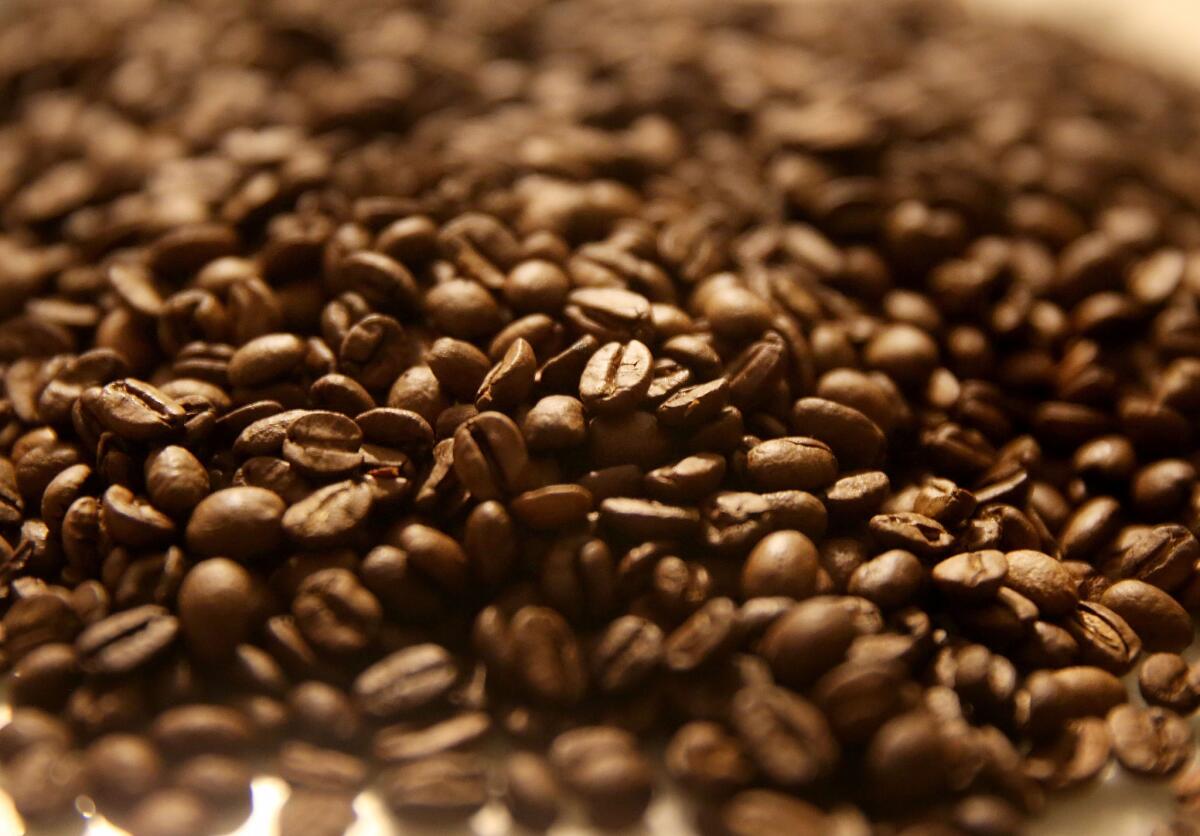Meet the genes in the beans of your coffee

- Share via
Wake up and smell the genome.
Researchers have pieced together the genetic atlas of the parent of the most commonly cultivated species of coffee plant and uncovered a rather independent streak in its evolution.
-----------
FOR THE RECORD
An earlier version of this post said 39 countries had exported 5.3 metric tons of coffee last year. Those countries exported 5.3 million metric tons.
-----------
Coffee developed its caffeine-generating capacity independently from its cousin, cacao, according to the first whole genome study of the plant behind the brew quaffed every morning by about 100 million Americans, published online Thursday in the journal Science.
There’s been a lot of genetic sleuthing on coffee, most of it far from the tree. We have a good idea about how caffeine affects animal (particularly human) genes and alters brain chemistry. We know which of our own genes seem to draw us toward consuming coffee, tea or chocolate as well. And there’s also been a heady, if somewhat contradictory, brew of studies purporting to demonstrate caffeine’s beneficial and deleterious effects on humans.
But how caffeine production got started has been as hard to see as a spoon in a demitasse of espresso.
“Coffee has been kind of an orphan crop,” said UC Davis geneticist Juan F. Medrano, who was not involved in the study. “It has been kind of forgotten in terms of DNA research. Perhaps this opens the door to expand that area.”
The international team that spent years piecing together coffee’s massive genome suggests that a caffeine chemical factory developed independently at least twice, in cacao and coffee, in what’s known as convergent evolution. (Koalas and humans, for instance, have fingerprints, and widely divergent animals have developed prickly outsides to protect their gooey insides.)
Compared with its close relatives, coffee harbors larger families of the genes linked to aroma and bitterness and has a wider array of genes linked to caffeine production, the study found.
How those new genes popped up and proliferated appears to be a series of small, fortuitous accidents, the study suggests. Neighboring genes were duplicated by a process roughly equivalent to erratic coding and processing in a computer. Unlike computers, biological systems are ruthless housekeepers, shucking duplicates like excess baggage. Sometimes duplicates develop their own specialty, which appears to be what happened in the case of coffee, the authors suggest.
“A small percentage of them survive, either by splitting functions or evolving new ones,” said study coauthor Victor A. Albert, an evolutionary biologist at the University at Buffalo, part of the State University of New York. “In the case of caffeine genes, we have a series of duplications that occurred all next to each other, which gave rise to enzymes that catalyze different steps” in caffeine production.
Evolution favored caffeine production because the compound repels insects that prey on leaves and halts the germination of seeds from competing plants, giving coffee species a niche in which to thrive. Recent research also has suggested caffeine can help orient beneficial pollinators toward the coffee flower, Albert said.
Duplication of an entire genome is thought to be a primary driving force in the rise of new species and the wide diversification of life. But coffee appears to have taken a slower, piecemeal approach of small duplications. That could mean biologists have been underestimating the contribution of narrow, sequential duplication to species diversity, Albert said.
The common ancestor of coffee and such plants as cacao, tomatoes, grapes, papaya, soybeans, strawberries, peaches and poplars experienced no such whole-genome duplication.
“Yet the coffee family is the fourth-largest family of flowering plants and it’s very diverse in flower, plant and fruit form,” Albert said. “Here’s a diversification without a whole genome duplication having stimulated it.”
The largely French team of researchers used crushed stems, leaves and flower parts from Coffea canephora, one of the parents of the hybrid Coffea arabica, from which the bulk of coffee is brewed. They produced an annotated genome that consists of 710 million building blocks.
The ensuing database is expected to boost researchers’ ability to study the highly sensitive plant behind the top revenue-generating export of dozens of nations on four continents. About 39 countries exported 5.3 million metric tons coffee of coffee beans last year, according to the International Coffee Organization, a trade group.
A tropical perennial, coffee has a relatively narrow temperature and rain tolerance, and its cultivation is threatened by shifting climate patterns and by several pests. Researchers have been eager to find ways to boost the plant’s natural defenses, while others have successfully created strains that are all but caffeine-free. Food corporations such as Nestle have patented genetically modified coffee plants.
Genetic research and development could have profound economic and social impacts, said Medrano of UC Davis.
Coffee crops in Central America were badly damaged last year after a climate swing from humid to arid conditions, driving up prices and putting about 370,000 people out of work, Medrano said.
Climate change has allowed a fungal blight to “explode,” spreading to higher altitudes where the best quality coffee is cultivated, Medrano said. “Climate change has had a dramatic effect on coffee,” he said.
Medrano and other UC Davis researchers have been studying how to apply DNA technology to breed coffee that is more resistant to blight and climate fluctuations.
“There is an opportunity in the future to do GMOs, but our interest at UC Davis is to apply plant breeding technologies to improve the sustainability of coffee,” Medrano said. “There’s a social and cultural component to coffee. It affects the lives of so many people.”
Like a daily cup of science? Follow @LATsciguy.







